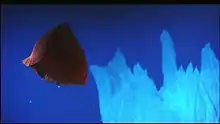Poralia
Poralia is a genus of jellyfish in the family Ulmaridae. It is a monotypic genus containing a single species, Poralia rufescens.[1] This jellyfish is pelagic, and is found in deep water in most of the world's oceans.
| Poralia | |
|---|---|
 | |
| Scientific classification | |
| Kingdom: | Animalia |
| Phylum: | Cnidaria |
| Class: | Scyphozoa |
| Order: | Semaeostomeae |
| Family: | Ulmaridae |
| Genus: | Poralia Vanhöffen, 1902 |
| Species: | P. rufescens |
| Binomial name | |
| Poralia rufescens Vanhöffen, 1902 | |
Description
Poralia rufescens has a bell about 9 cm (3.5 in) in diameter. It has 30 marginal tentacles interspersed with 15 rhopalia (sensory organs). The lappets (flaps) are rectangular in outline and are all the same length, the rhopalial lappets having deep clefts and the tentacular lappets shallow clefts.[2] This jellyfish is very fragile and most specimens examined have been damaged.[3][4]
Distribution
The distribution of this mesobathypelagic species is not well delineated. Before 1962, only eleven damaged specimens from the North Atlantic had been examined, mostly brought up from waters deeper than 1,500 m (4,900 ft).[3] It seems to be quite common in the vicinity of Bermuda and the Bahamas, mostly in the lowest 100 m (300 ft) of the water column.[4]
In a study of deep sea jellyfish in the Southern Ocean performed by the USNS Eltanin, the coronates Periphylla periphylla, Atolla wyvillei and Atolla chuni were the most common species found, comprising over 90% of the individuals sampled. P. rufescens was the most common semaeostome, making up 2% of the collection.[5] A study using a remotely operated vehicle in deep water in the Japan Trench showed that P. rufescens was the most common scyphomedusan there.[6] It has also been recorded from several locations in the eastern Pacific Ocean, including off the coast of southern California.[7]
Ecology
The biology and ecology of the mesobathypelagic jellyfishes is poorly known.[7] Their gelatinous bodies tend to have a low proportion of protein; P. rufescens has a protein content of 0.1% of the body dry weight as compared to an average of 4% for all gelatinous taxa. Some parts of the body have a higher nitrogenous content than others, and in the Pacific, leatherback sea turtles, whose diet consists largely of jellyfish, have been observed feeding on their gonads and tentacles, the parts which have the highest nutritional values.[8]
References
- "WoRMS – World Register of Marine Species – Poralia rufescens Vanhöffen, 1902". www.marinespecies.org. Retrieved 29 January 2018.
- Fautin, Daphne G.; Westfall, Jane A.; Cartwright, Paulyn; Daly, Marymegan; Wyttenbach, Charles R. (2005). Coelenterate Biology 2003: Trends in Research on Cnidaria and Ctenophora. Springer Science & Business Media. p. 542. ISBN 978-1-4020-2761-1.
- Russell, F.S. (1962). "On the scyphomedusa Poralia rufescens Vanhöffen" (PDF). Journal of the Marine Biological Association of the United Kingdom. 42 (2): 387–390. doi:10.1017/S0025315400001375.
- Williams, R.B.; Cornelius, P.F.S.; Hughes, R.G.; Robson, E.A. (2012). Coelenterate Biology: Recent Research on Cnidaria and Ctenophora. Springer Science & Business Media. p. 315. ISBN 978-94-011-3240-4.
- Larson, Ronald J. (1986). "Pelagic Scyphomedusae (Scyphozoa: Coronatae and Semaeostomeae) of the Southern Ocean". Biology of the Antarctic Seas. XVI (1). doi:10.1002/9781118666579.ch3 (inactive 10 January 2021).CS1 maint: DOI inactive as of January 2021 (link)
- Lindsay, Dhugal J.; Furushima, Yasuo; Miyake, Hiroshi; Kitamura, Minoru; Hunt, James C. (2003). The scyphomedusan fauna of the Japan Trench: preliminary results from a remotely-operated vehicle. Coelenterate Biology. Developments in Hydrobiology. 178. pp. 537–547. doi:10.1007/978-1-4020-2762-8_61. ISBN 978-1-4020-2761-1.
- Larson, R.J. (1990). "Scyphomedusae and Cubomedusae from the Eastern Pacific". Bulletin of Marine Science. 47 (2): 546–556.
- Capone, Douglas G.; Bronk, Deborah A.; Mulholland, Margaret R.; Carpenter, Edward J. (2008). Nitrogen in the Marine Environment. Academic Press. p. 1755. ISBN 978-0-12-372522-6.
External links
| Wikimedia Commons has media related to Poralia. |